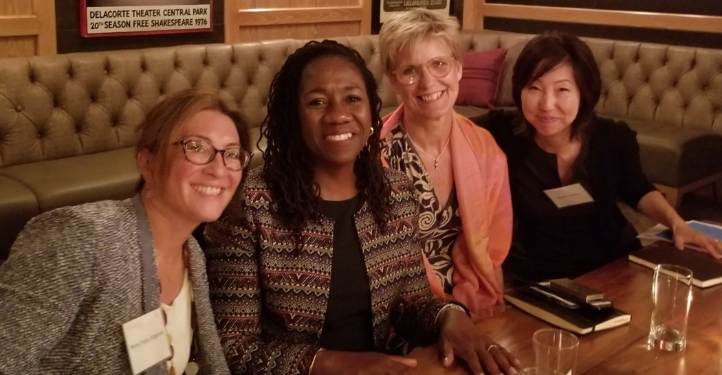Criminal Justice Reform: A Conversation with Key Experts and the RPA Board of Directors
July 18, 2017
“What would a truly ‘just’ criminal justice system look like?”
This question, posed by moderator Penny Fujiko Willgerodt, Executive Director of The Prospect Hill Foundation, kicked off Rockefeller Philanthropy Advisors’ invitation-only Conversation on Criminal Justice Reform featuring Sherrilyn Ifill of the NAACP Legal Defense Fund, Carroll Bogert of The Marshall Project, and Helena Huang of the Art for Justice Fund held on July 10, 2017 in New York City.
Responding to that provocative query, Ifill opined that a central tenet of a truly just system would be a recognition of the humanity of all who are in the system—even those convicted of the most violent offenses. If we acknowledge their humanity, it follows that they are entitled to i) be regarded as an individual, entitled to the protections of our Constitution, as opposed to being painted with the broad brush of an odious stereotype; and ii) the assumption that they will return to mainstream society, underlining the need for education and rehabilitation services.
The role of the media in criminal justice reform also came up. Bogert, president of The Marshall Project, gave an example of the media’s influence on policy. From a historical perspective, she noted the Washington Post’s use of the term “drug scourge” 1,565 times in a one year period from 1988-1989, citing coverage such as this as central in driving mandatory minimum prison sentences. On a more positive note, Bogert highlighted a recent success driven by effective journalism. There are currently 19 states (and even more county-based systems) in which parents can be charged fees for the incarceration of their child. In a recent story published on the front page of the Washington Post, The Marshall Project highlighted a private lawyer in Philadelphia who was paid $316,000 a year —more than even the mayor of the city — for being the conduit to charging those parents by setting up one-on-one meetings and presenting them with bills. Within hours after the publication of this article, the city of Philadelphia announced that it would stop its program of billing parents. This dramatic policy change is a great example of the power of the media and its potential to create positive change.
As in most discussions about criminal justice reform, the role of for-profit entities was raised. Several in the room stressed the importance of investors having a full understanding of their possible complicity and the implications of their business decisions and professional associations. This issue is not just limited to the prison management companies; it extends to the food service providers, healthcare entities, transportation companies and others within the criminal justice industry — often charging the already-stressed population exorbitant rates that would be unacceptable in any other context.
Ifill noted that criminal justice reform should not just focus on incarceration. She stated that just one touch with the criminal justice system can be enough to transform a life, and therefore our focus should be on minimizing the number and intensity of these touches. A touch from the criminal justice system can have long-term effects such as through the misuse of criminal background checks by employers or landlords – decades after an arrest. Huang introduced the new Art for Justice Fund as a new funding vehicle designed to advance the end of mass incarceration with the goal of reducing the prison population in targeted states by 20% over the next five years by investing in leading advocacy organizations and artists. Art for Justice Fund grantmaking strategies include attacking the three drivers of incarceration (number of people who enter the system, length of stay, number of people who return to prison after release) by reforming excessive sentences, shifting funding from prisons to proven crime prevention strategies, eliminating cash bail in key jurisdictions, improving pathways to education and employment, and using the arts to humanize those in the criminal justice system.
In the end, the discussion encouraged us, as we consider what a truly just system looks like, to look at who is getting what rewards. Huang spoke of the importance of having people with lived experience with the criminal justice system (people formerly incarcerated, people who are survivors of crime and their family members) having the support they need to lead, particularly in this unique moment of opportunity. She reflected on the many ways philanthropy can and must support this leadership, including higher education in prison, fellowships, robust support for organizations led by people more impacted, and opportunities to write books to tell powerful stories that can change hearts and minds.
How can we change incentives so the organizations and government entities involved behave differently? What would happen if instead of paying private prison companies based on the number of prisoners, we paid based on the prisoner outcomes? What would our system look like if, instead of cost-per-head, we focused on rehabilitation and future success?
While some of those ideals may be for the longer-term, programs like Art for Justice Fund, The Marshall Project, the NAACP Legal Defense Fund and many others are helping drive real, ongoing change to bring us closer to that goal.
Get involved! Learn more about Art for Justice Fund, The Marshall Project and the NAACP Legal Defense Fund and their respective activities by visiting their websites.
Click here for more information about Rockefeller Philanthropy Advisors’ current projects.
Back to News